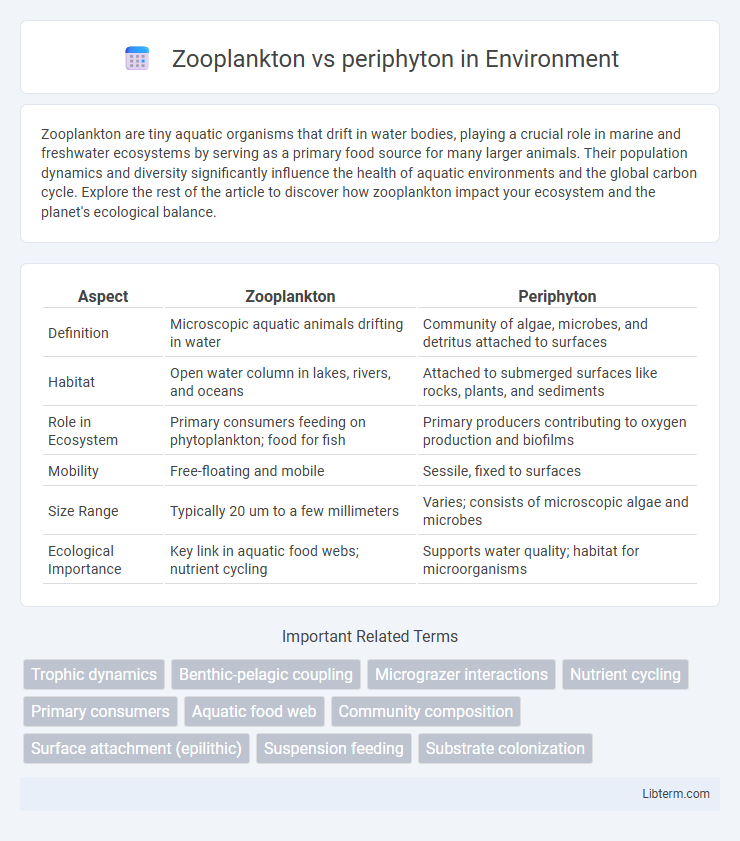Zooplankton are tiny aquatic organisms that drift in water bodies, playing a crucial role in marine and freshwater ecosystems by serving as a primary food source for many larger animals. Their population dynamics and diversity significantly influence the health of aquatic environments and the global carbon cycle. Explore the rest of the article to discover how zooplankton impact your ecosystem and the planet's ecological balance.
Table of Comparison
| Aspect | Zooplankton | Periphyton |
|---|---|---|
| Definition | Microscopic aquatic animals drifting in water | Community of algae, microbes, and detritus attached to surfaces |
| Habitat | Open water column in lakes, rivers, and oceans | Attached to submerged surfaces like rocks, plants, and sediments |
| Role in Ecosystem | Primary consumers feeding on phytoplankton; food for fish | Primary producers contributing to oxygen production and biofilms |
| Mobility | Free-floating and mobile | Sessile, fixed to surfaces |
| Size Range | Typically 20 um to a few millimeters | Varies; consists of microscopic algae and microbes |
| Ecological Importance | Key link in aquatic food webs; nutrient cycling | Supports water quality; habitat for microorganisms |
Introduction to Zooplankton and Periphyton
Zooplankton are microscopic animals that drift in aquatic environments, serving as a crucial link in the food web by consuming phytoplankton and organic detritus. Periphyton consists of complex communities of algae, bacteria, and other microorganisms attached to submerged surfaces, providing a primary food source and habitat for aquatic organisms. Both zooplankton and periphyton contribute significantly to nutrient cycling and energy flow in freshwater and marine ecosystems.
Definitions: What are Zooplankton and Periphyton?
Zooplankton are microscopic or small aquatic animals that drift in water columns, serving as a crucial link in aquatic food webs by feeding on phytoplankton and being prey for larger animals. Periphyton consists of complex communities of algae, cyanobacteria, heterotrophic microbes, and detritus attached to submerged surfaces in aquatic environments, contributing significantly to primary production and nutrient cycling. Both zooplankton and periphyton play essential roles in freshwater and marine ecosystems, supporting biodiversity and ecosystem functions.
Habitat Differences
Zooplankton primarily inhabit the pelagic zone of aquatic ecosystems, drifting freely in open water environments such as lakes, oceans, and ponds. Periphyton thrives attached to submerged surfaces, including rocks, plants, and sediments within benthic or littoral zones where sunlight supports photosynthesis. These contrasting habitats influence their ecological roles, with zooplankton serving as mobile consumers and periphyton acting as primary producers in aquatic food webs.
Structural and Functional Characteristics
Zooplankton are microscopic animals characterized by their ability to actively swim, possessing diverse morphologies such as appendages for locomotion and feeding structures to capture prey, which enable them to function as primary consumers in aquatic food webs. Periphyton consists of complex assemblages of algae, bacteria, and detritus attached to submerged surfaces, featuring a mucilaginous matrix that facilitates nutrient absorption and provides habitat structure for microinvertebrates. The structural differences between the motile, heterotrophic zooplankton and the sessile, autotrophic periphyton reflect their distinct ecological functions--zooplankton contribute to energy transfer in pelagic zones, while periphyton plays a key role in nutrient cycling and habitat formation in benthic environments.
Role in Aquatic Ecosystems
Zooplankton serve as primary consumers in aquatic ecosystems, feeding on phytoplankton and transferring energy to higher trophic levels such as fish. Periphyton, a complex mixture of algae, bacteria, and detritus attached to submerged surfaces, plays a critical role in nutrient cycling and oxygen production by photosynthesis. Together, zooplankton and periphyton maintain ecosystem stability by supporting food webs and enhancing water quality through their biological activities.
Food Web Interactions
Zooplankton consume phytoplankton and periphyton as essential food sources, linking primary producers to higher trophic levels in aquatic ecosystems. Periphyton, composed of algae, bacteria, and detritus attached to submerged surfaces, supports herbivorous invertebrates that in turn serve as prey for zooplankton. These interactions facilitate nutrient cycling and energy flow, influencing population dynamics and ecosystem stability in freshwater and marine food webs.
Contribution to Nutrient Cycling
Zooplankton contribute to nutrient cycling by grazing on phytoplankton and recycling nutrients through excretion, enhancing nutrient availability in aquatic ecosystems. Periphyton, a complex assemblage of algae, bacteria, and detritus attached to submerged surfaces, plays a critical role in nutrient uptake and transformation, particularly filtering and absorbing dissolved nutrients directly from the water column. Together, these communities facilitate nutrient turnover, supporting food web productivity and maintaining ecosystem health in freshwater and marine environments.
Environmental Importance and Sensitivities
Zooplankton play a critical role in aquatic food webs by consuming phytoplankton and serving as a primary food source for larger organisms, thus maintaining ecosystem balance and nutrient cycling; however, they are highly sensitive to water temperature changes, pollution, and oxygen depletion. Periphyton, a complex assembly of algae, bacteria, and detritus attached to submerged surfaces, contributes significantly to primary production, nutrient retention, and habitat complexity in freshwater environments, but is particularly vulnerable to sedimentation, chemical contaminants, and alterations in flow regimes. Both zooplankton and periphyton serve as early indicators of environmental stress, reflecting the health and stability of aquatic ecosystems.
Methods for Studying Zooplankton vs Periphyton
Methods for studying zooplankton typically involve plankton nets with fine mesh sizes to collect samples from water columns, followed by microscopic identification and biomass quantification. Periphyton analysis requires scraping substrates or using artificial substrata samplers to gather attached algal communities, with subsequent chlorophyll-a measurement and microscopy for species composition. Both approaches use digital imaging and molecular techniques like DNA barcoding to improve taxonomic resolution and ecological assessments.
Summary: Key Differences and Similarities
Zooplankton are microscopic aquatic animals that drift in water columns, serving as primary consumers by feeding on phytoplankton, while periphyton consists of complex assemblages of algae, bacteria, and detritus attached to submerged surfaces. Both play critical roles in aquatic ecosystems, contributing to nutrient cycling and forming foundational links in food webs, yet zooplankton are free-floating organisms whereas periphyton are benthic and sessile. The key differences lie in their mobility, habitat attachment, and trophic functions, with zooplankton generally being heterotrophic consumers and periphyton primarily autotrophic producers.
Zooplankton Infographic

 libterm.com
libterm.com